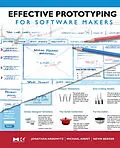Effective Prototyping for Software Makers is a practical, informative resource that will help anyone-whether or not one has artistic talent, access to special tools, or programming ability-to use good prototyping style, methods, and tools to build prototypes and manage for effective prototyping. This book features a prototyping process with guidelines, templates, and worksheets; overviews and step-by-step guides for nine common prototyping techniques; an introduction with step-by-step guidelines to a variety of prototyping tools that do not require advanced artistic skills; templates and other resources used in the book available on the Web for reuse; clearly-explained concepts and guidelines; and full-color illustrations and examples from a wide variety of prototyping processes, methods, and tools. This book is an ideal resource for usability professionals and interaction designers; software developers, web application designers, web designers, information architects, information and industrial designers. * A prototyping process with guidelines, templates, and worksheets;* Overviews and step-by-step guides for 9 common prototyping techniques;* An introduction with step-by-step guidelines to a variety of prototyping tools that do not require advanced artistic skills;* Templates and other resources used in the book available on the Web for reuse;* Clearly-explained concepts and guidelines;* Full-color illustrations, and examples from a wide variety of prototyping processes, methods, and tools. * mkp.com/prototyping
Autorentext
Jonathan Arnowitz is a User Experience Architect at Google Inc. and is the co-editor-in-chief of Interactions Magazine. Most recently Jonathan was a User Experience Architect at SAP Labs and was a Senior User Experience Designer at Peoplesoft. He is a member of the SIGCHI extended executive committee, and was a founder of DUX, the first ever joint conference of ACM SIGCHI, ACM SIGGRAPH, AIGA Experience Design Group, and STC.
Klappentext
Effective Prototyping for Software Makers is a practical, informative resource that will help anyone-whether or not one has artistic talent, access to special tools, or programming ability-to use good prototyping style, methods, and tools to build prototypes and manage for effective prototyping.
This book features a prototyping process with guidelines, templates, and worksheets; overviews and step-by-step guides for nine common prototyping techniques; an introduction with step-by-step guidelines to a variety of prototyping tools that do not require advanced artistic skills; templates and other resources used in the book available on the Web for reuse; clearly-explained concepts and guidelines; and full-color illustrations and examples from a wide variety of prototyping processes, methods, and tools.
This book is an ideal resource for usability professionals and interaction designers; software developers, web application designers, web designers, information architects, information and industrial designers.
* A prototyping process with guidelines, templates, and worksheets;* Overviews and step-by-step guides for 9 common prototyping techniques;
* An introduction with step-by-step guidelines to a variety of prototyping tools that do not require advanced artistic skills;
* Templates and other resources used in the book available on the Web for reuse;
* Clearly-explained concepts and guidelines;
* Full-color illustrations, and examples from a wide variety of prototyping processes, methods, and tools.
* www.mkp.com/prototyping
Inhalt
Chapter 1: Why Prototyping?
Chapter 2: The Effective Prototyping Process
Phase I: Plan Your Prototype
Chapter 3: Verify Prototype Assumptions and Requirements
Chapter 4: Develop Task Flows and Scenarios
Chapter 5: Define Prototype Content and Fidelity
Phase II: Specification of Prototyping
Chapter 6: Determine Characteristics
Chapter 7: Choose a Method
Chapter 8: Choose A Prototyping Tool
Phase III: Design Your Prototype
Chapter 9: Establish the Design Criteria
Chapter 10: Create the Design
Phase IV: Results of Prototyping
Chapter 11: Review the Design
Chapter 12: Validate and Iterate the Prototype
Chapter 13: Deploy the Design
Chapter 14: Card Sorting Prototyping
Chapter 15: Wireframe Prototyping
Chapter 16: Storyboard Prototyping
Chapter 17: Paper Prototyping
Chapter 18: Digital Interactive Prototyping
Chapter 19: Blank Model Prototyping
Chapter 20: Video Prototyping
Chapter 21: Wizard-of-oz Protoyping
Chapter 22: Coded Prototyping
Chapter 23: Prototyping with Office Suite Applications
Chapter 24: Prototyping with Visio
Chapter 25: Prototyping with Acrobat
Glossary
Subject Index
